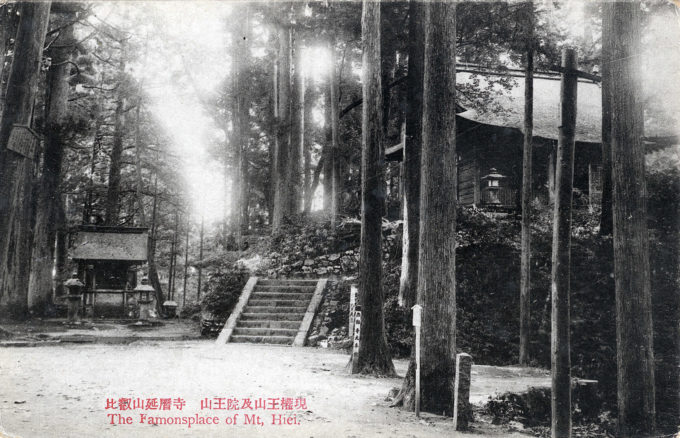
“The Famous Place of Mt. Hiei”, Enryakuji, Kyoto, c. 1930. Enryakuji was the ‘mother’ temple of the monastery founded by Saicho (767-822) during the early Heian period (794–1185), introducing the Tendai sect of Mahayana Buddhism to Japan from China.
See also:
Ascending Mt. Hiei, Kyoto, c. 1930.
Ise Asakuma Funicular Cable Car, Toba, Mie Prefecture, c. 1930.
“Five yrs. before the Emperor Kwammu founded Kyoto (in A.D. 794), the bonze Saicho (from 866 onward known by the posthumous title of Dengyo-daishi) erected a small temple on the summit of Hiei-san and called it Enryaku-ji, from the era (782-806) in which it was founded. He had just returned from China whither he had gone to study the doctrines of the Tendai sect, which he now proceeded to diffuse from the new headquarters.
“In time, the temple became a great monastery which was destined to bear much the same relation to most of the later sects established in Japan that the Church of Rome bears to the various forms of Protestantism.
“It was to be at once the common mother and the enemy of them all.”
– Terry’s Japanese Empire, T. Phillip Terry, 1914
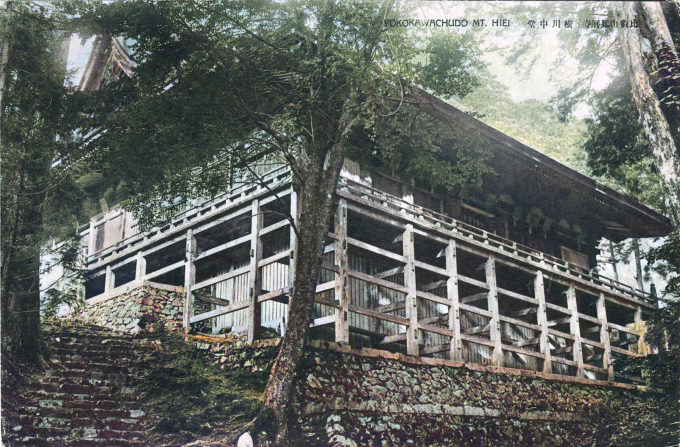
“Yokawa-chūdō”, Mt. Hiei, Kyoto, c. 1930. (Colorized) The Yokawa area’s main temple hall, houses the Sho kannon bosatsu, a wooden statue of the Bodhisattva of Compassion said to date back to the Heian Period.
“From the cable terminus to the top of Hiei-zan is 8 cho (about 1/2 M.), over a good road [but] which is apt to be deep in mud in wet weather. Rubbers [boots] necessary.
“The Cable Car Mt. Hiei”, Kyoto, c. 1930, the steepest in the country, extends only about halfway up the mountain. To reach the monastery and temples closer to the summit, a further trek on foot or by litter was required (until completion of a ropeway in the 1930s).
“Coolies with kagos [transport litter] await non-walkers, and for a small fee will carry them to the summit. Men and women offer to push one up the broad (no dizzy places) road by placing a huge crutch against one’s back.
“The thousands of pine trees on the hill slopes were planted by the Red Cross. The wind (fu) which eternally sighs through them is poetically referred to as shofu (‘wind breathing through pines’) because the sound is pleasant and restful.
“The crest of the mt. is marked by numerous rest houses, some stone lanterns, seats, and a sculptured image (worn by time) of Denkyo Daishi (distinguished, with Kobo Daishi, as one of the most profound scholars that ever came to Japan). The views are so awe-inspiring that they thrill one into silence.
“Hence to the Konpon-chūdō (Original Central Philosophical Hall) and the Dai-kōdō (Great Lecture Hall, founded in A.D. 1150, repaired in 1925) is 1 M. (16 cho). The road leads down through a pine forest and soon broadens into a charming forest lane between majestic cryptomerias overlooking steep ravines in the midst of a great solitude.
- Mt. Hiei, c. 1920. Pilgrims being carried by kago [transport litter].
- Mt. Hiei, c. 1920. Pilgrims being carried by kago [transport litter].
“Great bronze and stone lanterns face the entrance to the superb old Dai-kōdō, which overlooks (in a ravine just below) the Konpon-chūdō. If the traveler will strike (with the swinging wood beam) the great Dai-kōdō Bell, he will hear the same powerful tone ring and echo through the silent glades that called the devotees to prayer 775 years ago! Its resonant, commanding voice is splendid.
“To the student of Buddhism it perchance may recall the fact that in the halcyon days of monkish power in this sequestered retreat the great Dai-kōdō and Konpon-chūdō were links in a chain of temples that stretched hence beyond the Miyako Hotel (a section of which is still one of the oil temples) to Kyomizu-dera.
“In all there were 3000 buildings, and the entrance to the vast enclosing compound stood where the Kyoto Zoo logical Garden now is. The property belonged to the Tendai Sect (which still predominates at Nikko); indubitably the most scientific and the most spiritually advanced of all the Buddhist shus [schools] in the Empire. The sect is sometimes referred to as the Unitarians of Buddhism. Then, as now, a Shinto Shrine stood in the enclosure of every Buddhist temple (tera).”
– Terry’s Guide to the Japanese Empire, T. Philip Terry, 1928


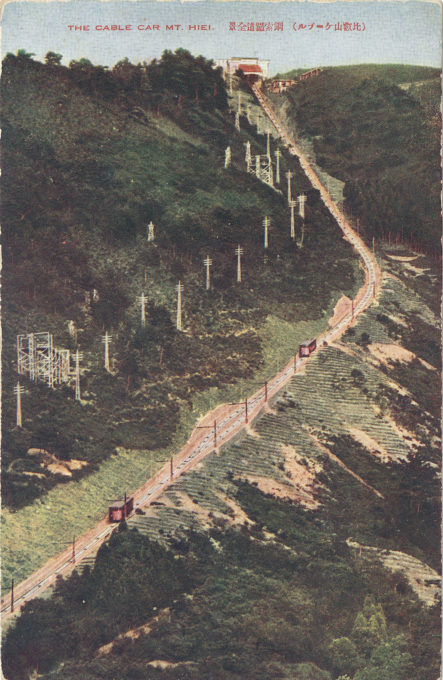
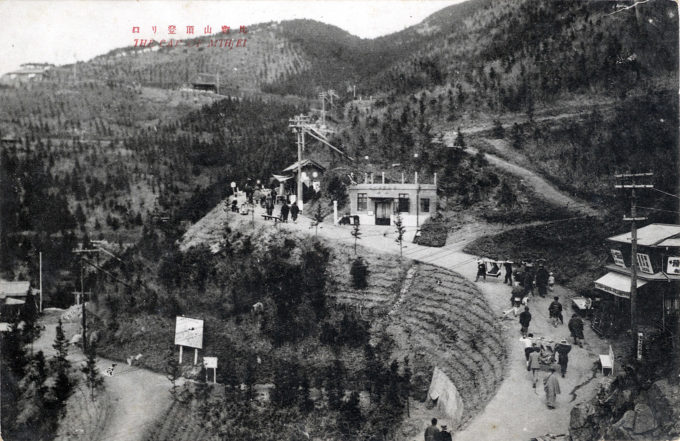
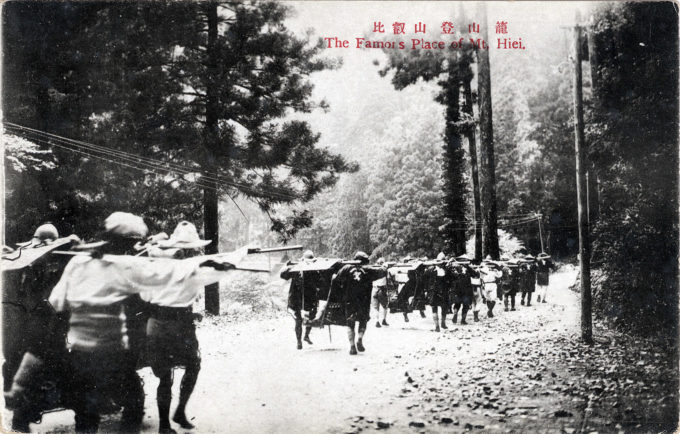
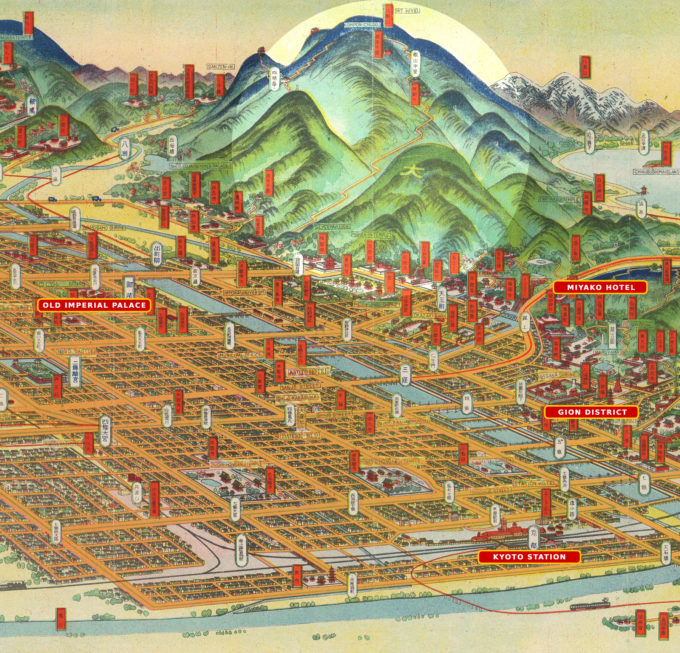
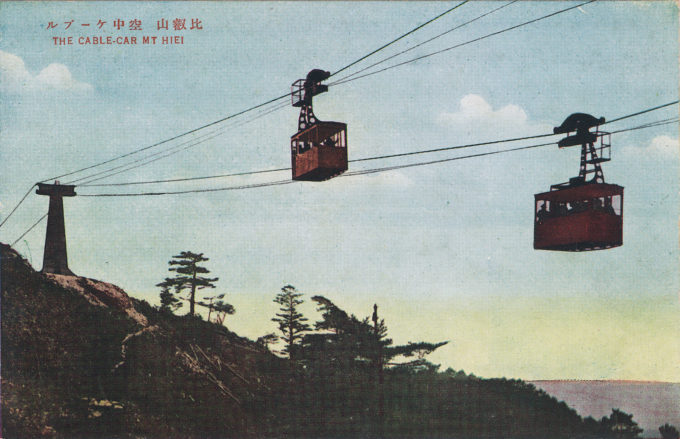
Pingback: Mt. Kasagi postcard series, Kyoto, c. 1930. | Old Tokyo
Pingback: Ascending Mt. Hiei, Kyoto, c. 1930. | Old Tokyo